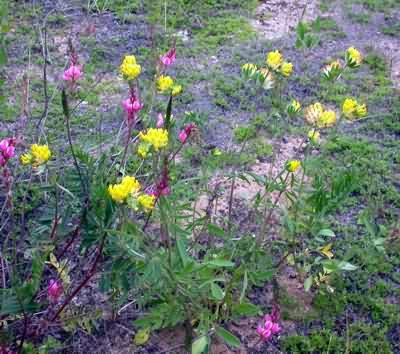Relatives
Anthyllis vulneraria L. - Kidney Vetch, Common Kidneyvetch.
Taxonomic position.
Family Fabaceae Lindl., genus Anthyllis L.Synonyms.
A. linnaei (Sagor.) Juz.; A. vulneraria subsp. linnaei Sagor.Morphology and biology.
Annual, biennial or perennial plant 30-40 cm tall with 1-10 stems. Stems pale green or turning red, slender, arcuately ascendent or prostrate, simple or with small leafless shoots arising from cauline leaf axils in upper part of the plant and bearing one, often underdeveloped head. Stems covered throughout with dense, short, closely adpressed hairs. Radical leaves simple or imparipinnate with 1-3 pairs of usually underdeveloped lateral leaflets and a large elliptic terminal leaflet. Leaflets glabrous above, covered with short and quite sparse adpressed hairs beneath. Cauline leaves of 1-4 pairs of elongate or linear-lanceolate leaflets and with a broader and longer terminal leaflet, evenly arranged along stem. All leaflets above glabrous or with sparse hairs, beneath densely pubescent with adpressed hairs. Flower heads on main stem single, on long stalk or subsessile, 1,5-3 cm diameter, neither dense nor many-flowered. Floral leaves as long as or shorter than calyx, dissected almost to half, with broad, somewhat acute lobes. Calyx 6-9 mm long and 2,5-4 mm wide, densely covered with short hairs, bicolour: pale in lower part, dark purple in upper part. Corolla of various colour: red, white, yellow or mix-coloured. Standard about 6 mm long, 4 mm wide, with unguis 6 mm long. Flowers in June - July, fruits in August. Entomophilous. Zoochore. 2n=12.Distribution.
General distribution: Scandinavia, Atlantic and Central Europe. Former USSR - Baltic countries (Estonia), Leningrad Region.Ecology.
Maritime meadows and shrubberies, forest fringes, exposed dry herbaceous sites, wastelands, fields, stony and rocky cliffs and slopes, principally on calcareous soils, mainly at coasts of the Baltic Sea.Use and economic value.
Forage: pasturing, grown as pure crop and in mixed herbages; melliferous; technical: flowers and leaves are used for making blue and yellow natural dye; medicine: anaplerotic; source of saponin.References:
Wulf VV., Maleyeva OF. 1969. The world resources of useful plants (food, forage, technical, medicine etc.). Reference book. Leningrad: Nauka. P.218. (In Russian).Fedorov AA., Tzvelev NN., ed. 1987. Flora of the European part of the USSR. V.6. Leningrad: Nauka. P.100. (In Russian).
Shishkin BK., ed. 1945. Flora URSS. V.11. P.265-266. (In Russian).
Cherepanov SK. 1995. Vascular plants of Russia and adjacent states (the former USSR). St.Petersburg. 990 p. (In Russian).


